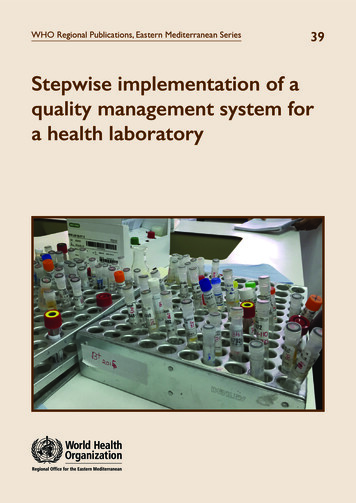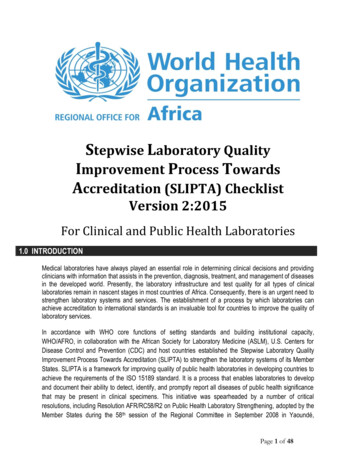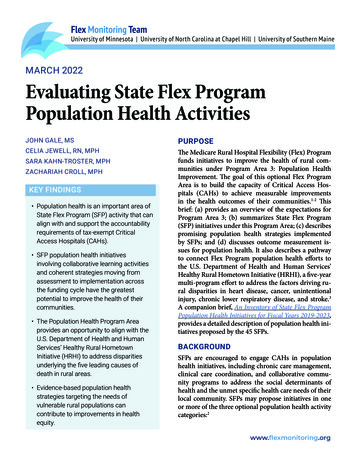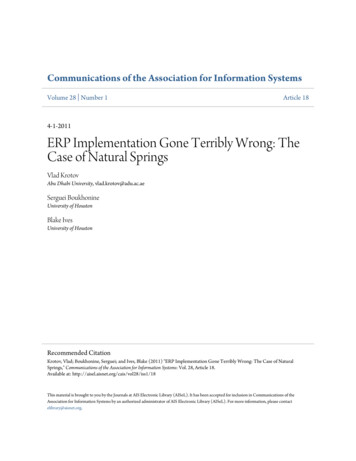
Transcription
WHO Regional Publications, Eastern Mediterranean Series39Stepwise implementation of aquality management system fora health laboratory
WHO Regional Publications, Eastern Mediterranean Series39Stepwise implementation of aquality management system fora health laboratory
WHO Library Cataloguing in Publication DataWorld Health Organization. Regional Office for the Eastern MediterraneanStepwise implementation of a quality management system for a health laboratory / World Health Organization.Regional Office for the Eastern Mediterraneanp. .- (WHO Regional Publications, Eastern Mediterranean Series; 39)ISBN: 978-92-9022-142-5ISBN: 978-92-9022-143-2 (online)ISSN: 1020-041X1. Laboratories - standards 2. Quality Control 3. Clinical Laboratory Services - standards 4. Public HealthPractice I. Title II. Regional Office for the Eastern Mediterranean III. Series(NLM Classification: WA 23) World Health Organization 2016All rights reserved.The designations employed and the presentation of the material in this publication do not imply the expression ofany opinion whatsoever on the part of the World Health Organization concerning the legal status of any country,territory, city or area or of its authorities, or concerning the delimitation of its frontiers or boundaries. Dotted lineson maps represent approximate border lines for which there may not yet be full agreement.The mention of specific companies or of certain manufacturers’ products does not imply that they are endorsedor recommended by the World Health Organization in preference to others of a similar nature that are notmentioned. Errors and omissions excepted, the names of proprietary products are distinguished by initial capitalletters.All reasonable precautions have been taken by the World Health Organization to verify the information containedin this publication. However, the published material is being distributed without warranty of any kind, eitherexpressed or implied. The responsibility for the interpretation and use of the material lies with the reader. In noevent shall the World Health Organization be liable for damages arising from its use.Publications of the World Health Organization can be obtained from Knowledge Sharing and Production, WorldHealth Organization, Regional Office for the Eastern Mediterranean, PO Box 7608, Nasr City, Cairo 11371, Egypt(tel: 202 2670 2535, fax: 202 2670 2492; email: emrgoksp@who.int). Requests for permission to reproduce, inpart or in whole, or to translate publications of WHO Regional Office for the Eastern Mediterranean – whetherfor sale or for noncommercial distribution – should be addressed to WHO Regional Office for the EasternMediterranean, at the above address: email: emrgoegp@who.int.Design, layout and printing by WHO Regional Office for the Eastern Mediterranean, Cairo, EgyptCover photo shows triage and preparation of patient specimens for processing and examination. WHO/K Nahapetyan
ContentsAcknowledgements. 71. Introduction.112. Purpose of the document.132.1 Scope and objectives.132.2 Target audience.142.3 How to use the document.143. Essential elements of national quality standards.153.1 Structure and organization.153.2 Facilities and environmental conditions.173.3 Human resources.193.4 Laboratory equipment, reagents and consumables .203.5 Examination processes and quality assurance of examination results.223.6 Quality management system.253.7 Procurement and supply management.303.8 Management and examination of laboratory specimens.313.9 Safety.353.10 Laboratory information management.373.11 Ethical conduct.384. Stepwise implementation strategy.394.1 General introduction .394.2 National level.404.3 Laboratory level.42Glossary.43Correlation table.45Bibliography.48
AcknowledgementsAcknowledgementsThis document was developed and edited by the following:Sébastien Cognat, WHO Lyon Office, Lyon, FranceFolker Spitzenberger, Deutsche Akkreditierungsstelle GmbH, Berlin, GermanyMohammad Youssef, WHO Lyon Office, Lyon, FranceHala Esmat Tolba, WHO Regional Office for the Eastern Mediterranean, Cairo,EgyptKaren Nahapetyan, WHO Regional Office for the Eastern Mediterranean, Cairo,Egypt.The following contributed to development and review of the document:Rainer Haeckel, Deutsche Akkreditierungsstelle GmbH, Berlin, GermanyPanadda Silva, Department of Medical Sciences, Ministry of Public Health, Nonthaburi,ThailandHeinz Zeichhardt, Institut für Virologie, Berlin, GermanyEvgeniy Gavrillin, WHO Regional Office for Europe, Copenhagen, DenmarkGulam Eshan Sharifi, Central Public Health Laboratory, Ministry of Health, Kabul,AfghanistanBashir Uddin Noormal, Afghanistan National Public Health Institute, Ministry ofHealth, Kabul, AfghanistanShah Agha Ghulam Rabani, Kabul Medical University, Kabul, AfghanistanMohammad Yousuf Mubarak, Kabul Medical University, Kabul, AfghanistanAmjad Ghanem Zaed Mohamed, Public Health Laboratory, Ministry of Health,Manama, BahrainNermin Kamal Hasan Saeed, Salmanyia Medical Complex, Ministry of Health,Manama, BahrainAzza Sadiq Eldanasoury, Central Public Health Laboratory, Ministry of Health andPopulation, Cairo, EgyptDina Ramadan Lithy, Central Public Health Laboratory, Ministry of Health andPopulation, Cairo, EgyptNuman Abdul Lateef Abdul Razak, Directorate of Public Health, Ministry of Health,Baghdad, Iraq7
Stepwise implementation of a quality management system for a health laboratoryHassan Yassir Jaber, Department of Technical Affairs, Ministry of Health, Baghdad,IraqMarjan Farzami, Reference Health Laboratory, Ministry of Health and MedicalEducation, Tehran, Islamic Republic of IranNooshafarin Safadel, Reference Health Laboratory, Ministry of Health and MedicalEducation, Tehran, Islamic Republic of IranKatayoon Khodaverdian, Reference Health Laboratory, Ministry of Health andMedical Education, Tehran, Islamic Republic of IranRafiq Abdel Rahman Saleh, Central Public Health Laboratories, Ministry of Health,Amman, JordanGaia Al-Wahdani, Central Public Health Laboratories, Ministry of Health, Amman,JordanTarek Al-Sanouri, Central Public Health Laboratories, Ministry of Health, Amman,JordanMohammed El-Khateeb, Faculty of Medicine, University of Jordan, Amman, JordanYousif Bilto, Faculty of Science, University of Jordan, Amman, JordanAla Qutishat, Chemistry and Endocrinology Laboratories, Al-Bashir Hospital,Amman, JordanNadera Eid Al-Shareef, Central Public Health Laboratories, Ministry of Health,Amman, JordanHaifa Ali Isleem, Central Public Health Laboratories, Ministry of Health, Amman,JordanNayef Ismaeel Al Hazaymeh, Jordanian Royal Medical Services, Amman, JordanNuha Yousef Obeid, Jordan University of Science and Technology, Irbid, JordanRanda Salah Yousef, Jordan University Hospital Laboratory, Amman, JordanLana Marashdeh, Accreditation Unit, Jordan Standards and Metrology Organization,Amman, JordanFawaz Allabadi, Jordan National Metrology Institute, Royal Scientific Society,Amman, JordanAdel Mastori, Syndicate of laboratories, Beirut, LebanonHala El Hout, Central Public Health Laboratory, Ministry of Public Health, Beirut,LebanonSamia Chatila, Central Public Health Laboratory, Ministry of Health, Beirut, Lebanon8
AcknowledgementsOmar Elahmer, Reference Laboratory, National Centre for Disease Control, Tripoli,LibyaAbdulaziz Zorgani, National Centre for Disease Control, Tripoli, LibyaRhizlane Selka, Institut National D’Hygiène, Ministry of Health, Rabat, MoroccoSuleiman Al-Busaidy, Central Public Health Laboratory, Ministry of Health, Muscat,OmanSalaam Al Rashdi, Ministry of Health, Muscat, OmanWaadalla Sharef, Biochemistry Department, Royal Hospital, Muscat, OmanIbrahim Salem, Central Public Health Laboratory, Ministry of Health, Ramallah,PalestineAli Jahahja, Central Public Health Laboratory, Ministry of Health, Ramallah, PalestineSanjay H. Doiphode, Hamad Medical Corporation, Doha, QatarSittana Shalseldin Elshafie, ASPETAR, Qatar Orthopedic and Sport MedicineHospital, Doha, QatarMansour Al-Zarouni, Department of Pathology and Laboratory MedicineSharjah Medical District, Ministry of Health, Sharjah, United Arab EmiratesKamal Khan, Pathology and Genetics Department, Dubai Health Authority, Dubai,United Arab EmiratesOsama Melhem, Abu Dhabi Quality and Conformity Council, Abu Dhabi, UnitedArab EmiratesNada Al Qassimi, Abu Dhabi Quality and Conformity Council, Abu Dhabi, UnitedArab EmiratesKhaled Saeed Alshaibani, National Centre of Public Health Laboratories, Ministry ofPublic Health and Population, Sanaa, YemenMahmoud Ojaily, National Public Health Laboratories, Ministry of Public Health andPopulation, Sanaa, YemenPawan Angra, United States Centers for Disease Control and Prevention, Atlanta,United States of AmericaMark Rayfield, United States States Centers for Disease Control and Prevention,Atlanta, United States of AmericaIngo Schellenberg, Centre of Life Sciences, Anhalt University of Applied Sciences,Köthen (Anhalt), Germany9
Introduction1. IntroductionHealth laboratory services are essential for human health care because decisions ondiagnosis, treatment and prognosis are often based on the results and interpretationsof medical laboratory tests. To assure and improve the level of patient care whilesimultaneously limiting the related costs, the implementation of quality systems inmedical laboratories has expanded worldwide in recent years.International standard ISO 15189 “Medical laboratories – requirements for qualityand competence” was developed for medical laboratories by the InternationalOrganization for Standardization (ISO). That standard imposes stringent requirementson laboratories that many are unable to fulfil, especially in resource-limited countries.As an outcome of the Joint World Health Organization (WHO)/Centers for DiseaseControl and Prevention (CDC) Conference on Health Laboratory Systems, Lyon,France, 9–11 April 2008, the following statement was issued.International efforts are under way to develop health laboratory standards that helpto ensure quality. These efforts should be supported as follows. (i) Each countryshould establish its own set of standards according to country-specific needs basedon internationally agreed standards. (ii) National laboratory standards need to takeinto account local factors, including any pertinent regulations, organization of thecountry’s laboratory system(s), and resource constraints. (iii) It is recommendedthat countries with limited resources consider taking a staged approach, whereprincipal requirements for all are stated in the national laboratory standards as aminimum requirement while more advanced and national reference laboratoriesare encouraged to aim at meeting internationally accepted standards such as ISO15189.For Member States of the WHO Eastern Mediterranean Region, a WHO workshopon strengthening laboratory quality systems and promoting national laboratoryplanning was held in October 2010 in Oman. The workshop concluded with severalrecommendations that emphasized, in particular, that Member States should promotenational laboratory quality systems through the adoption of national standards, whichshould be based on the internationally recognized standards, and that implementationof those standards by Member States should follow a step-wise approach, with the11
Stepwise implementation of a quality management system for a health laboratoryeventual goal of meeting international standards. WHO was recommended to takethe lead in developing harmonized national and regional guidance to support MemberStates in development and implementation of their national laboratory qualitystandards, and that can be practically implemented by all types of health laboratories,and adapted by other types of public health facilities, such as food- or water-testinglaboratories. Such guidance should lead stepwise to compliance with internationalquality standards, such as ISO 15189, and include a system for internal qualitycontrol and use of reliable external quality assessment schemes operated by qualifiedproviders in the Region.This document was developed in response to the above recommendations and tosatisfy a significant need for practical procedures and guidance on quality assuranceand quality management in health laboratory diagnostics in the Region.12
Purpose of the document2. Purpose of the document2.1 Scope and objectivesThis document aims to support health laboratories to implement essential elementsof quality assurance and quality management according to national health laboratorypolicies and systems. It presents a minimum set of standards that can be readilyadapted by countries in the Eastern Mediterranean Region and applied to laboratoriesat every level of the health care system. It can also be used to develop a practicalstrategy for the preparation and implementation of national guidelines for qualityassurance and quality management in health laboratories, on the basis of the qualityelements provided by this guidance and after adaptation to meet local and nationalrequirements. The guidance will also support national policy-makers and regulatorsin developing national quality standards.Health laboratories are the primary focus of this document. Here, a health laboratoryis defined as the basic unit, comprising single or multiple rooms (technical rooms,reception, offices, storage and wash rooms), which apply analytical methods toprovide results for a defined health-related purpose, such as medical research, medicaldiagnostics, disease surveillance, and food testing. Most of the health laboratoriesare medical or clinical laboratories for biological, microbiological, immunological,chemical, immuno-haematological, haematological, biophysical, cytological,pathological, genetic or other examination of human specimens, to provide informationfor diagnosis, management, prevention and treatment of disease, or assessment ofhealth. The laboratories may provide a consultant advisory service covering all aspectsof laboratory investigation, including interpretation of results and advice on furtherappropriate investigation. Although this guidance focuses on medical laboratories, theprinciples laid down are also applicable to other types of health laboratory, such asfood or water testing.Countries with existing national laboratory quality standards are encouraged to reviewthem regularly, guided by this document. The review process or establishment ofstandards should be carried out through a national laboratory coordinating committeeunder the auspices of the Ministry of Health.13
Stepwise implementation of a quality management system for a health laboratoryThis document is based on the internationally recognized standards and good practicesgoverning laboratory services but is not intended to replace existing internationalor national standards. Instead, it supports the stepwise and continual improvementtowards full implementation of a comprehensive quality management system, incompliance with relevant national and/or international regulations.2.2 Target audienceThe intended audience of the document is any stakeholder involved in medical andhealth laboratory examinations, such as ministries of health, laboratory managers,quality officers and technical laboratory staff, national public health laboratories and/or focal points, national regulatory health authorities, providers of external qualityassessment schemes (EQAS), professional societies and manufacturers of in vitrodiagnostic medical devices.2.3 How to use the documentThe document and its recommendations related to the implementation strategy(Section 4) can be readily used as they stand, or after adaptation to meet national/localrequirements. The guidance should be read as recommendations for development andimplementation of national quality standards that can be implemented by all types ofmedical and health laboratories. It emphasizes implementation of a quality systemcovering essential or minimal criteria that can lead stepwise to compliance withinternational quality standards, such as ISO 15189.Together with other tools provided by WHO, such as the Laboratory assessment tool,Laboratory quality stepwise implementation tool and Laboratory quality managementsystem training toolkit (see Bibiliography), this guidance might also be used to supportsituational and gap analysis and implementation of quality management systems in thelaboratories of the national health laboratory system.A correlation table is provided at the end of the guidance to help users understand thelinks between this document and ISO 15189.14
Essential elements of national quality standards3. Essential elements of national qualitystandards3.1 Structure and organization3.1.1 Legal identityThe laboratory, or the organization of which the laboratory is a part, should be anentity that can be held legally responsible for its activities.3.1.2 Laboratory directorThe laboratory should be directed by a person or persons with the authority andcompetence to be responsible for the services provided. The responsibilities ofthe laboratory director should include professional, consultative or advisory,organizational, administrative and educational matters relevant to the services offeredby the laboratory.Although the laboratory director may delegate selected duties to qualified personnel,the director should maintain responsibility for the overall operation and administrationof the laboratory.The laboratory director (or those designated for delegated duties) should have thenecessary competence, authority and resources in order to: provide effective leadership of the medical laboratory service; ensure that there are appropriate numbers of staff with the required education,training and competence to provide medical laboratory services that meet theneeds and requirements of the users; ensure and monitor the systematic implementation and sustainability of the qualitymanagement system; implement a safe laboratory environment in compliance with good practice andapplicable requirements; ensure the provision of clinical advice with respect to the choice of examinations,use of the service and interpretation of examination results;15
Stepwise implementation of a quality management system for a health laboratory select referral laboratories and monitor the quality of their service (see also Section3.7.4); monitor all work performed in the laboratory to determine that clinically relevantinformation is being generated; address any complaint, request or suggestion from staff and/or users of laboratoryservices (see also Section 3.6.5); design and implement a contingency plan to ensure that essential services areavailable during emergency situations or other conditions when laboratory servicesare limited or unavailable; and if applicable (e.g. for laboratories with public health functions), ensure that thelaboratory fulfils its public health functions (e.g. networking activities, supervision,and surveillance).Note. Contingency plans should be periodically tested.3.1.3 Responsibility, authority and inter-relationshipsThe laboratory director should ensure that responsibilities, authorities and interrelationships are defined, documented and communicated within the laboratoryorganization. This should include the appointment of person(s) responsible for eachlaboratory function and appointment of deputies for all key functions.Note. It is recognized that in smaller laboratories individuals can have more than one function and that itcould be impractical to appoint deputies for every function.Laboratory management should ensure that appropriate communication processes areestablished within the laboratory, and that communication takes place regarding theeffectiveness of the pre-examination, examination and post-examination processesand quality management system. In particular, effective communication should beensured for specific laboratory clients and stakeholders, such as ministries of health,disease control programmes and funding agencies.3.1.4 Quality managerThe laboratory director should appoint a quality manager who should have, irrespectiveof other responsibilities, delegated responsibility and authority that include:16
Essential elements of national quality standards ensuring that processes needed for the quality management system are established,implemented and maintained; reporting to the laboratory director on laboratory policy, objectives andresources, on the performance of the quality management system and any needfor improvement; and ensuring the promotion of awareness throughout the laboratory organization of therequirements of the quality management system and the needs and requirementsof users.3.2 Facilities and environmental conditions3.2.1 GeneralThe laboratory should have space allocated for the performance of its work that isdesigned to ensure the quality and safety of the service provided to the users, and thehealth and safety of laboratory personnel, patients, visitors and the environment.3.2.2 Laboratory and office facilitiesThe laboratory and associated office facilities should have adequate space and providean environment suitable for the tasks to be undertaken, to ensure that: access to areas affecting the quality of examinations is controlled;Note. Access control should take into consideration safety, confidentiality, quality and prevailingpractices. signs for restricted areas and access controls to laboratories are provided; medical information, patient samples and laboratory resources are safeguardedfrom unauthorized access; facilities for examination allow correct performance of examinations, includingenergy sources, lighting, ventilation, noise, water, waste disposal andenvironmental conditions; and safety facilities and devices are provided and their functioning regularly verified,for example, eye washes, showers and fire extinguishers.17
Stepwise implementation of a quality management system for a health laboratory3.2.3 Storage facilitiesStorage space and conditions should be provided that ensure the continuing integrityof samples, slides, histology blocks, retained microorganisms, documents, files,manuals, equipment, reagents, laboratory supplies, records and results.Clinical samples should be stored under appropriate conditions, separate from reagentsand materials used in examination processes, to prevent cross contamination.Specific biosafety and biosecurity measures should be taken to ensure safe storage ofhighly dangerous pathogens.3.2.4 Staff facilitiesThere should be adequate access to: hand-wash basins, including hand sanitization washrooms and toilets a supply of drinking water and facilities for food storage facilities for storage of personal protective equipment and clothing.Note. When possible, the laboratory should provide space for staff activities and a rest area.3.2.5 Patient sample collection facilitiesPatient sample collection facilities should have separate reception/waiting andcollection areas. Consideration should be given to the accommodation of patientprivacy, comfort, and needs and accommodation of appropriate accompanying personduring collection.Sample collection facilities should have and maintain appropriate first aid materials forboth patient and staff needs.3.2.6 Facility maintenance and environmental conditionsLaboratory premises should be maintained in a functional and reliable condition.Work areas should be clean and well maintained. Measures should be taken to ensuregood housekeeping and waste management. There should be policies in place forinfection control, maintenance, cleaning (facility, housekeeping and laboratorywaste), evacuation and hazardous events.18
Essential elements of national quality standardsAttention should be paid to environmental factors such as light, sterility, dust,radiation, humidity, electrical supply, temperature, directional airflow, and noiseand vibration levels, as appropriate to the activities concerned so that these do notinvalidate the results or adversely affect the required quality of any examination.Essential laboratory equipment should be supplied with a continuous uninterruptedpower supply.There should be effective separation between laboratory sections in which there areincompatible activities.3.3 Human resources3.3.1 GeneralThe laboratory should have a documented procedure for personnel hiring, trainingand management, and maintain records for all personnel that indicate compliancewith the requirements of this guidance.3.3.2 Job descriptionsLaboratory management should define and document personnel qualifications foreach position. The qualifications should reflect the appropriate education, training,experience and demonstrated skills needed, and be appropriate to the tasks performed.The laboratory should have job descriptions that describe responsibilities and tasksfor all personnel. Job descriptions should contain at least the following information: job titlerequired minimum qualificationskey tasksgeneral tasksaccountabilitydepartment in which the person will workinterfaces with other departmentsstaff responsibilities.19
Stepwise implementation of a quality management system for a health laboratory3.3.3 Training and continuing educationThe laboratory management should provide a continuous training programme for allpersonnel that includes the following: the quality management system assigned work processes and procedures health and safety, including the prevention or containment of the effects of adverseincidents ethics and confidentiality of patient information.Personnel at all levels should take part in appropriate continuing training andeducation.3.3.4 Personnel recordsRecords of the relevant educational and professional qualifications, training andexperience of all personnel should be maintained and readily available to relevantpersonnel.Note. Examples of personnel records are copies of certification and/or license, previous work experience,job descriptions, training in current job tasks, records of continuing education and achievements, andimmunization status, if relevant to assigned duties.3.4 Laboratory equipment, reagents and consumables3.4.1 Laboratory equipmentThe laboratory should be furnished with all equipment needed for the provision ofservices.Note. Laboratory equipment includes instrument hardware and software, measurement systems, andlaboratory information systems. Laboratories should not be storage places for inoperable or decommissionedequipment and their supplies.The laboratory should verify upon installation and before use that the equipment iscapable of achieving the necessary performance and that it complies with requirementsrelevant to any examinations concerned.Equipment should be operated at all times by trained and authorized personnel.20
Essential elements of national quality standardsCurrent instructions on the use, safety and maintenance of equipment, includingany relevant manuals and directions for use provided by the manufacturer of theequipment, should be readily available.Eac
Stepwise implementation of a quality management system for a health laboratory / World Health Organization. Regional Office for the Eastern Mediterranean p. .- (WHO Regional Publications, Eastern Mediterranean Series; 39) ISBN: 978-92-9022-142-5 ISBN: 978-92-9022-143-2 (online) ISSN: 1020-041X 1. Laboratories - standards 2. Quality Control 3.










